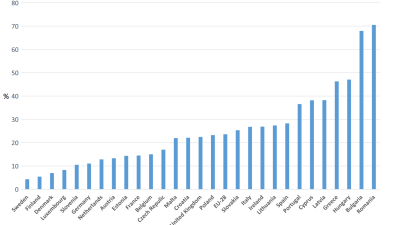The government's consultation paper on Measuring Child Poverty is ‘conceptually completely inept and confused’, argues Professor Jonathan Bradshaw in the PSE research team’s response to the consultation. In particular, ‘it fails to recognise the fundamental distinction between measures of poverty and the characteristics of poor children and the associations and the consequences of poverty’.
Bradshaw, in the PSE Policy working paper (No. 8), criticises the consultation paper as being of ‘very poor quality’, ignoring not only the vast amount of academic research in this area and the work of previous governments, but also this government's previous consultations. For example, the consultation paper inaccurately claims that ‘The measures in the Child Poverty Act focus heavily on income to measure child poverty. They do not capture the full experience of growing up in poverty or the barriers to getting out of poverty’. This completely ignores the Child Poverty Act's deprivation measure which is given just one short paragraph in the whole consultation document. Further, it ignores the extensive tables in the official Households Below Average Income (HBAI) publication that give the rates and composition of children in poverty.
Bradshaw rejects the consultation paper’s central argument that there is an ‘urgent need to rethink our approach to measuring child poverty’ because, using the relative measure of 60% of median income, child poverty fell in 2010/11 as a result of median incomes falling. ‘It is surely a good thing that the poor became less poor relative to the median? It means that they caught up a bit, are less left behind than they were. Of course their living standards did not improve and this is clearly shown using the absolute (consistent) poverty measure. Material deprivation also probably did not improve. This why in HBAI we have a portfolio of measures and do not rely on one only.’
The HBAI already covers the five criteria set out in the consultation paper for a multi-dimensional measure of poverty - namely that it should cover numbers, severity, groups, public acceptability and robustness. In particular, ‘the deprivation measure has been tested and retested for public acceptability using the PSE socially perceived necessities methods’ which draws directly on the public's perception of what is necessary to live in the UK today and that which no-one should have to go without.
Bradshaw and the PSE team dismiss many of the possible dimensions of a multi-dimensional poverty measures set out in the consultation paper as simply not measuring poverty, in particular, the proposed dimensions of worklessness, poor skill level, access to quality education, family stability and parental health.
‘Defining poverty in terms of worklessness makes no sense’, argues Bradshaw, ‘It is a characteristic of many (but far from all) households with children in poverty or a factor associated with child poverty. But it is not a very good one.’ A majority of children in poverty live in a household where at least one adult is in work and this proportion has been rising sharply over the last ten years.
Equally, family stability and family structure are not measures of poverty. Most poor children live in two-parent families and while there is a higher risk of child poverty in lone parent and cohabiting families this is a function of UK social policy. “It is not inevitable and some other countries avoid this association”, the PSE working paper argues.
Bradshaw and the PSE team conclude: ‘The conceptual basis of these proposed dimensions is so confused it is very difficult to know what it would achieve or indeed how it could used.’
Source: PSE policy response working paper, No. 8: Child Poverty Measurement, Jonathan Bradshaw and PSE team
Links: Measuring Child Poverty: A consultation on better measures of child poverty, Department of Work and Pensions.



 PSE:UK is a major collaboration between the University of Bristol, Heriot-Watt University, The Open University, Queen's University Belfast, University of Glasgow and the University of York working with the National Centre for Social Research and the Northern Ireland Statistics and Research Agency. ESRC Grant RES-060-25-0052.
PSE:UK is a major collaboration between the University of Bristol, Heriot-Watt University, The Open University, Queen's University Belfast, University of Glasgow and the University of York working with the National Centre for Social Research and the Northern Ireland Statistics and Research Agency. ESRC Grant RES-060-25-0052.






